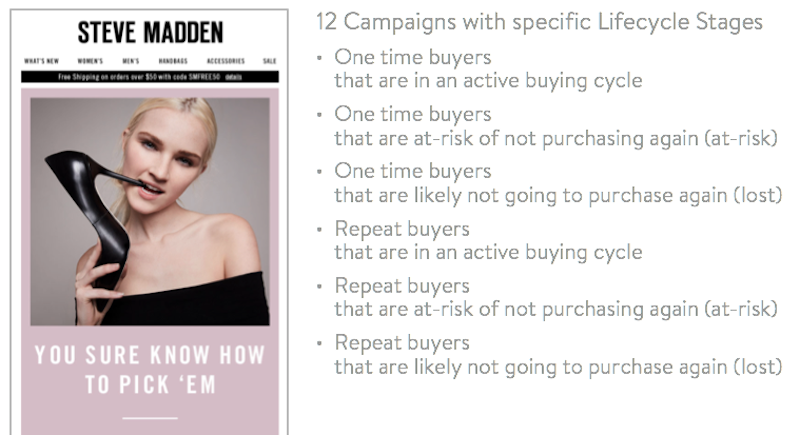
From Catalogs to Ecommerce: How Steve Madden Approaches Decisioning
Let me start by stating the obvious: Retail marketing today is remarkably different than it once was. Whereas marketing has historically been about retailers deciding what to push to consumers, the power has now shifted. We’ve entered an age where consumers want more relevant, targeted marketing from brands, and retailers are now rushing to adapt their marketing strategies.
Against this backdrop, online retailers have struggled with three main things:
- Acting on data
- Communicating with customers in meaningful ways
- Testing and iterating on marketing strategies quickly
What’s curious about these struggles is that the catalog business, which we now look at as an outdated method of marketing, actually solved for a lot of these problems. It seems we’re so blinded by trying to be innovative, that we fail to see why the catalog industry worked so well and how we can apply those learnings to help overcome the challenges we face currently.
Mark Friedman, President of ecommerce at Steve Madden, took the stage at CRMC last week to talk through the current challenges facing ecommerce marketers and how he and his digital team are taking lessons from the catalog business to help ride the wave of change with significantly less friction.
Don’t Be So Quick to Knock the Catalog Business
According to Friedman, who spent a good portion of his career working in catalogs, the catalog business knew how to use big data before big data was even a thing. He explained that catalog companies were built on the idea that they would need to target their customers in a very personalized way, and they organized data in a way that made it easy to take action as a result. The catalog business did this by building their systems to store customer data in a flexible manner that made it relatively easy to segment customers by geography, lifetime value, lookalikes or anything else.
But when ecommerce entered the scene, instead of taking the catalog data warehouse model, teams took the in-store point of sale model, which made it easy for them to collect data but difficult for them to take action on that data.
Where Ecommerce Marketing Falls Short
Since its inception, the ecommerce side of retail has been plagued by the three data-related challenges noted above. These challenges come down in large part to several key characteristics that have shaped ecommerce:
- Slow adoption of technology: The ability to take action on data has been slow to come to fruition in ecommerce. It’s not that retailers themselves were slow, it’s that the technology that allows retailers to do deep targeting was slow to come to market. This left ecommerce teams using POS-like systems that were not designed for their unique environment.
- Complex technology stacks: Catalog teams had just as much data as ecommerce retailers do, but their data was highly organized. Instead of having a well-designed data warehouse, most ecommerce teams use a handful of legacy systems that typically don’t play nicely with one another.
- Too much focus on traffic: In the early days of ecommerce, retailers were so focused on driving traffic to their sites that they failed to spend enough time looking at what happens after the sale. This laser focus on traffic left many ecommerce retailers with less than stellar rebuy rates, costs of acquisition and overall lifetime value numbers.
Turning the Ecommerce Marketing Story Around
The introduction of pure play ecommerce technology helped retailers move in the right direction by combining the best of POS systems with the best of data warehousing and segmentation. Equally as important, these platforms helped ecommerce teams expand their focus beyond traffic by measuring KPIs around rebuy rates, cost of acquisition and lifetime value.
Despite all this progress, there are many ways in which we’re no more sophisticated now than we were 20 years ago. For instance, ecommerce retailers still have mountains of customer data that they need to reconcile. But if you spend all of your time trying to reconcile data, you’d be out of a job and out of business. Instead, you need to focus on the data that’s immediately actionable. And once you do, you’ll begin to unlock an incredible amount of value.
How Steve Madden Infuses Ecommerce Marketing with Lessons from the Catalog Business
How exactly does Steve Madden take lessons from the catalog business and focus on data that’s immediately actionable to meet its ecommerce goals?
Friedman notes two of Steve Madden’s core digital goals:
- Increasing overall conversion rate
- Improving rebuy rate
To achieve these goals, Friedman:
- Empowers his team to take action on the data they have by using specific technology and giving them the freedom to test and iterate
- Prioritizes channels with the highest ROI (which is email for Steve Madden)
- Explores strategies to improve ROI within other channels (Steve Madden is currently focusing on display advertising)
Specifically, Friedman shared three efforts that his team at Steve Madden has implemented in order to achieve its goals.
Prioritizing Channels with High ROI: Email
Steve Madden now uses Bluecore to aggregate both its customer and catalog data into meaningful campaigns. The team runs triggered email campaigns, including cart abandonment, product abandonment, price decrease and pre-order triggers, as well as personalized batch campaigns.
While the triggered emails deliver immediate ROI for Steve Madden, the team has also found significant value in its personalized batch campaigns. For example, the ability to create more targeted audiences based on customer interest and feature dynamic products has transformed batch emails from a necessary evil of ecommerce into a powerful tool. And this targeted approach can not only increase revenue per email, but also help decrease unsubscribes.
Currently, the Steve Madden team builds audiences for personalized batch campaigns based on predictive analytics like category affinity and lifecycle stage, which has increased reach and revenue versus targeting customers based solely on past purchase behavior. The team even ran one campaign to test the difference and the impact was almost unbelievable. Targeting customers with a “high” and “very high” affinity toward the product category led to an audience that was 60x larger than just past buyers and all of the revenue from the campaign came from the affinity audience.

Exploring Strategies to Improve ROI on New Channels: Display Advertising
The Steve Madden team has also used Bluecore to bring intelligence to its cross-channel marketing efforts.
For example, the team is currently running ad campaigns on Facebook and Google AdWords that target customers with a high likelihood to convert. The team’s hypothesis is that the targeted nature of these campaigns could bring down the cost per conversion for these channels.

Improving Rebuy Rate with Targeted Email Campaigns
Finally, the Steve Madden team is using predictive audiences to achieve its goal of improving the rebuy rate. As part of this effort, the team decided to target previous purchasers based on predicted customer lifecycle stages. To do so, they split previous purchasers into a series of six “at-risk” and “lost” groups and then split each group by gender.

Following an initial test, the team set up a weekly trigger to go to customers who deviate from their personal buying cycle (aka become at-risk) or fall into the lost bucket and are likely not going to purchase again. Those emails feature personalized product recommendations based off the customer’s last purchase, and the hope is that, that targeted content will help win them back.
Ultimately, the team believes that this combination of monitoring for online purchasers and automated triggers will help prevent customers from churning.
Making Success a Reality
When it comes to acting on data and communicating with customers in meaningful ways, it appears that the Steve Madden team’s effort to learn from the catalog days has made all the difference.
Of course it’s one thing for ecommerce leaders like Friedman to get onstage at CRMC and talk about what they’re doing, but any marketer worth their salt knows that the devil is in the details. Far too many marketers have worked on programs that never saw the light of day because implementing them was technically and organizationally impossible.
What’s noteworthy about Friedman’s presentation is that he not only had tangible advice and stellar program performance details to share, but that he also was able to get those programs running within Steve Madden without any hassle.





